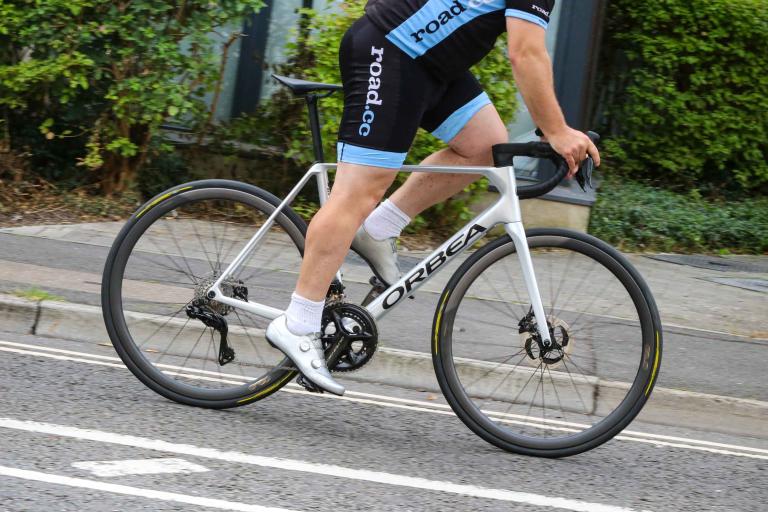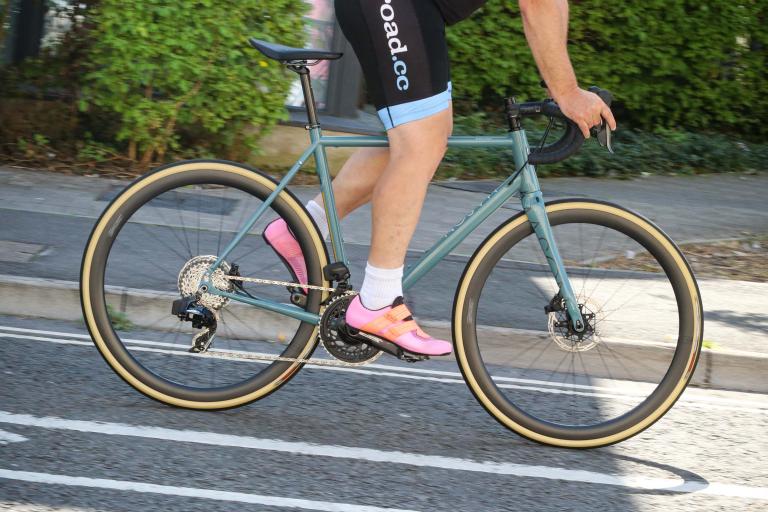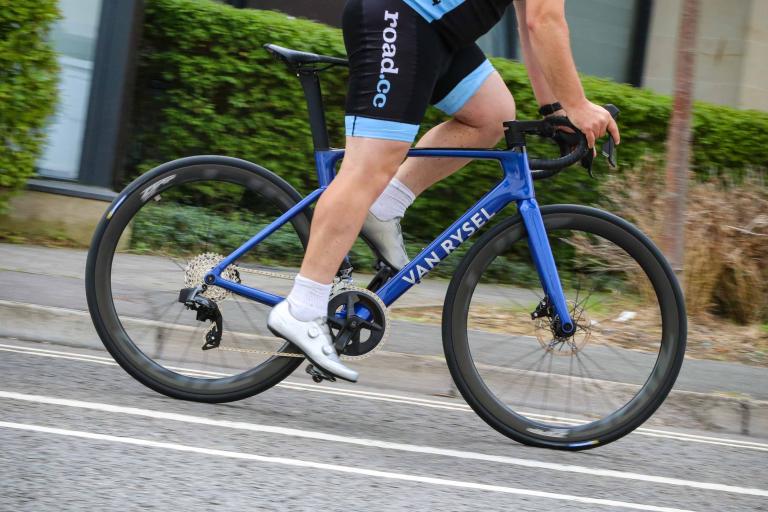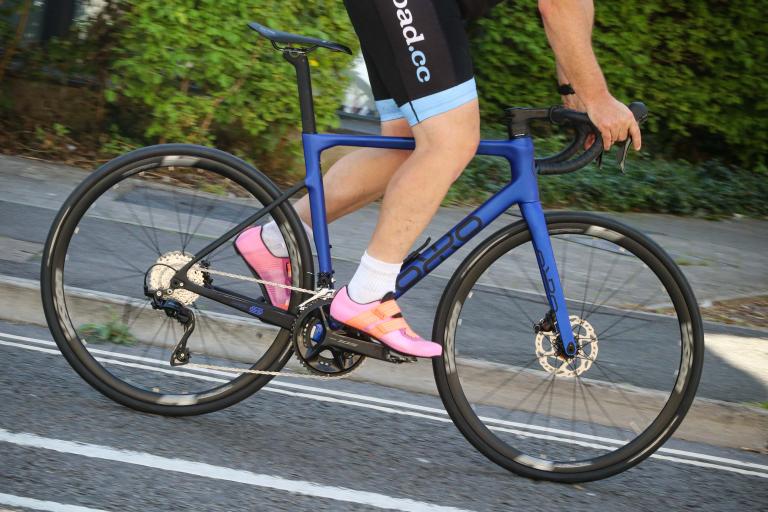- News
- Reviews
- Bikes
- Accessories
- Accessories - misc
- Computer mounts
- Bags
- Bar ends
- Bike bags & cases
- Bottle cages
- Bottles
- Cameras
- Car racks
- Child seats
- Computers
- Glasses
- GPS units
- Helmets
- Lights - front
- Lights - rear
- Lights - sets
- Locks
- Mirrors
- Mudguards
- Racks
- Pumps & CO2 inflators
- Puncture kits
- Reflectives
- Smart watches
- Stands and racks
- Trailers
- Clothing
- Components
- Bar tape & grips
- Bottom brackets
- Brake & gear cables
- Brake & STI levers
- Brake pads & spares
- Brakes
- Cassettes & freewheels
- Chains
- Chainsets & chainrings
- Derailleurs - front
- Derailleurs - rear
- Forks
- Gear levers & shifters
- Groupsets
- Handlebars & extensions
- Headsets
- Hubs
- Inner tubes
- Pedals
- Quick releases & skewers
- Saddles
- Seatposts
- Stems
- Wheels
- Tyres
- Health, fitness and nutrition
- Tools and workshop
- Miscellaneous
- Buyers Guides
- Features
- Forum
- Recommends
- Podcast
review
£3,299.00
VERDICT:
Light, handmade Italian frame with a solid Campag build results in a fast and efficient road bike
Weight:
7,200g
Contact:
www.comtat.co.uk
At road.cc every product is thoroughly tested for as long as it takes to get a proper insight into how well it works. Our reviewers are experienced cyclists that we trust to be objective. While we strive to ensure that opinions expressed are backed up by facts, reviews are by their nature an informed opinion, not a definitive verdict. We don't intentionally try to break anything (except locks) but we do try to look for weak points in any design. The overall score is not just an average of the other scores: it reflects both a product's function and value – with value determined by how a product compares with items of similar spec, quality, and price.
What the road.cc scores meanGood scores are more common than bad, because fortunately good products are more common than bad.
- Exceptional
- Excellent
- Very Good
- Good
- Quite good
- Average
- Not so good
- Poor
- Bad
- Appalling
London-based Comtat now have their frames handmade in Italy and the carbon Aristo is available in a variety of different Campagnolo-centred builds. We've been getting the miles in to find out whether the ride is as impressive as its classy looks...
Frame

Comtat's bikes are all built around one of two framesets. The top-level Sartorial is custom-made to suit your dimensions and typically weighs around 950g. It'll cost you £4,999.
The other frameset - the one we have here - is the Aristo, and it's available in a standard design at £1,599.99 or with an integrated seat post (the kool kidz are calling them ISPs, dontcha know) for £100 extra. Or you could go for a made-to-measure version with either a standard or integrated seat post, including a frame fitting with the nice chaps at Velo Solutions /content/feature/26270-bike-fit//, for £1,999.99. Two grand for a custom-made Italian frameset? That's worth thinking about.
We've gone for an off-the-shelf model built up with Campag Chorus components. You can get the same frameset with a Centaur build for £2,499.99, a Record build for £3,999.99, or Super Record for a big hike up in price: £6,399.99.
So, what are you getting for your cash here? The frame is made from Toray T800 carbon fibre which is good-quality, strong stuff. Rather than the frame being formed in a mould, carbon tubes are bonded together by hand with epoxy resin and part cured before each of the joints is wrapped with sections of pre-preg carbon fabric (where the reinforcing fibres are impregnated with a resin).
Those areas are taped and the frame goes into an autoclave (essentially, a high-pressure oven) where the joints become solid with ultra low voids - it's highly compact without air pockets in there. Then the lugs are smoothed off and the frame is painted and/or lacquered.
So it's a labour intensive process, which is why frames made this way are usually mega-pricey. £1,600 is hardly pocket money, clearly, but this isn't mass-produced in the Far East (and even there it's still a labour intensive process - they just use a lot of labour), and you get a five-year warranty against failure and defects.
The Aristo's front triangle looks pretty classic in a market where most tubes seem to be shaped and tapered and fluted and all the rest of it. These tube profiles are... wait for it... round. You know, circular. Remember? You couldn't call them skinny but they're by no means chunky either, the down tube, for example, having a 44mm diameter. Comtat stick with tried and tested standards for the bearings too, using 1 1/8in top and bottom for the headset and an outboard bottom bracket.
Things are more elaborate at the back, the wishbone seatstays triangulating in the lower section with a ridge on the outer edge (check out the pictures to get a better idea). The path they take from the seat tube to the dropouts is anything but straight; they kink out laterally (when viewed from the back) and horizontally (when viewed from the side). The chainstays are a similar design, although they have a more constant curve to them. Comtat reckon all this adds control, minimizing the chances of the back end stepping out in fast corners. The fork, which comes with both carbon steerer and blades, matches the frame perfectly.
Comtat market the Aristo as an Etape bike although different manufacturers have different takes on what qualities are necessary in a sportive machine. Some take an inch or so off the top tube and whack some extra length on the head tube so you end up with a more upright riding position than normal. The idea is that you reduce strain on your back so you're more comfortable... and that's a reasonable enough approach. Specialized, for example, do this with their Roubaix bikes.
Comtat, though, have kept the Aristo's geometry more like that of a traditional, race bike. We've got the large sized model here which comes with an effective top tube measurement of 55.8cm and a seat tube that would be around 54cm if the top tube didn't slope down slightly. The head tube is 15.5cm - which isn't particularly lofty. There are no headset spacers below the stem either, so the front end is fairly low. Not that that's a bad thing... it just depends what you're after.
All the cables run externally and the only eyelets are for two bottle cages. The finish is always going to be a matter of taste but I like the simple approach Comtat have taken here. Aside from the manufacturer's name and the model name, they've kept things to a minimum, the brand crest on the head tube and a thin line extending around the other tubes the only decoration. The whole thing is well lacquered so it glints in the sun.
Components

As mentioned, you can get the Aristo as a complete bike in various different builds. Ours came with Chorus components, Chorus being Campag's third tier groupset beneath Super Record and Record. It's all carbon fibre as far as the eye can see.
The rest of the spec is nearly all Italian too. The wheels are Fulcrum Racing 1 clinchers - which, essentially, come from Campagnolo although they don't shout about it - with a 26mm-deep aluminium rim at the front and 30mm at the rear, those rims milled away between the spoke holes. The hubs are smooth from the off while the spokes are bladed aluminium - 16 at the front, 21 at the rear. Racing 1s are a reasonable weight at about 1,600g the pair, and they roll on (non-Italian) Conti Grand Prix 4000 S tyres which are both fast and grippy.
The cockpit components come from Deda. We had a Zero 100 aluminium stem and handlebar although the standard bar is actually the carbon Presa. The seatpost is Deda too, a carbon Superzero, and Selle Italia's highly comfortable SLR Kit Carbonio saddle sits on top.
Although this is a stock bike, you get to choose the gearing, crank length, stem length, and bar width, and also the colour of the saddle, tyres and bar tape, so there's plenty of scope for making it your own.
Ride

The Aristo hit the scales at 7.16kg, or 15.8lb. For comparison, the £3,199 Wilier Triestina Gran Turismo that we tested is heavier at 7.65kg/16.8lb and the Canyon Ultimate CF SLX 8.0 (£2,609) we've just featured is a little lighter at 6.96kg (15.3lb). In other words, the Aristo is a decent weight for a road bike in this price band, even if it's not breaking down any barriers.
It accelerates well, the central section of the frame holding everything steady and Fulcrum's Racing 1s and the Conti GP 4000 S tyres gathering speed easily. Those wheels are pretty light (although not mega-light) and there's very little lost in the way of wheel flex so you get a feeling of direct power transfer when you put the hammer down.
The fork is reasonably stiff too. I occasionally noticed a very small amount of sideways movement when out of the saddle and throwing the bike around or leaning hard into a fast corner, but really not much. The aluminium cockpit components add more front-end stiffness. The front end actually felt harsh although that was down to the bar tape, pure and simple. The tape that adorned the Deda bar on our test bike was about as comfortable as sand in your chamois. There was no padding so every little judder that made it through the fork got transferred directly to my palms. Still, it's nothing that a tenner's worth of nice, soft cork tape wouldn't cure, so it's really not worth worrying about.
In contrast, resting on the hoods of the Chorus ErgoPower shifters is a really comfortable experience. You can perch your hands on the soft Vari-Cushion silicone hoods for hours and you'll never get any aches at all. Lovely.
The Selle Italia SLR keeps things equally comfy in the seating department. It weighs only 115g but there's just enough flex in the shell to make up for a lack of depth in the padding. To me, SLRs are the best lightweight saddles out there, damping out all manner of bumps and shakes from the worst British roads. Manufacturers make wild claims about how compliant their frames are but a good saddle like this counts more. I felt perfectly comfortable whether the ride was 20 miles or 100 miles - well, aside from that rubbish bar tape.
I've used Campagnolo's Super-Record groupset a lot recently and, to be honest, it isn't a massive step down to the Aristo's Chorus in terms of function. Chorus is a little heavier, yes, but not much considering the difference in price. Chorus Ergopower Ultra-Shift shifters weigh 337g, for example, while the Super Record equivalents are 330g. What's 7g between friends? There's more of a weight difference when it comes to the brake callipers and chainset, but it's still not great.
If you want to buy a complete Comtat bike, you have to go for a Campag groupset. I won't go into a full Campag versus Shimano versus SRAM debate here - chances are you have your own views already - but, briefly, why might you choose Campag over one of the other two?
Well, the higher Campag groupsets are 11-speed as opposed to 10-speed. You might want that extra sprocket. You might prefer the thumb-button/finger-lever shifting (on the other hand, you might not like it at all). It allows you, for example, to dump the chain onto the inner ring while you're braking. Not the biggest advantage ever, admittedly, but there you go. Or, just as likely, you might simply want a bit of Italian heritage on your bike, and who says there's anything wrong with that? (I don't subscribe, by the way, to the oft-repeated idea that Campag wears in while Shimano wears out on the basis that... well, it's nonsense).
The only bit of the Chorus groupset on the Aristo that I'm not particularly into is the single pivot rear brake (a dual pivot version is available too for 2011). It's just a bit weedy; it doesn't have the firepower of a Shimano alternative. It feathers off speed fine as you approach a tight corner but it lacks all-out stopping strength when you really want to weigh anchor. I wouldn't let it put me off the group as a whole, mind.
The Comtat climbs exactly how you'd expect a bike of this weight to climb: it doesn't hang about but gets the job done without any bother whether you're in or out of the saddle. There's nothing major to report on that front although you might prefer to go for a compact chainset rather than the 53/39T option we had on our test bike. It descends with poise too, and stays firmly stuck to the road even when you hit an off-camber rough patch. There's none of that sideways jumping about that can wreck your confidence.
So, who should buy the Comtat Aristo? We guess it'll be someone who wants something a bit different. Comtat are hardly a mainstream brand and there aren't too many bikes out there that come equipped with Campag Chorus groupsets.
Would the Aristo make a good Etape bike, as Comtat claim? Yes, it would, although that doesn't really mean much because different people want different characteristics in a bike for the Etape... or any other sportive. But if you're after something that blends light weight, with decent stiffness and an efficient ride position, this is an impressive bike for the money.
Verdict
A light, handmade Italian frame with a solid Campag build results in a fast and efficient road bike
road.cc test report
Make and model: Comtat Aristo
Size tested: Black 56cm
About the bike
State the frame and fork material and method of construction. List the components used to build up the bike.
See text on the method of frame construction.
Frame: Toray 800 intermediate modulus carbon fibre
Groupset: Campagnolo Chorus
Wheels: Fulcrum Racing 1
Handlebars: Deda Zero 100 aluminium
Stem: Deda Zero 100 aluminium
Seatpost: Deda Superzero carbon
Saddle: Selle Italia SLR Carbonio Kit
Tyres: Continental Grand Prix 4000S
Tell us what the bike is for, and who it's aimed at. What do the manufacturers say about it? How does that compare to your own feelings about the bike?
It's an all-round road bike: sportives, road racing and so on. Again, see the body of the text.
Frame and fork
Overall rating for frame and fork
10/10
Tell us about the build quality and finish of the frame and fork?
Excellent. It has been really well made and the finish is flawless.
Tell us about the materials used in the frame and fork?
Toray 800 intermediate modulus carbon fibre (often called high modulus in the bike industry); it's a good quality material.
Tell us about the geometry of the frame and fork?
We had a large size with an effective top tube of 55.8cm. It has a head tube of 15.5cm, a head tube angle of 73.25 and a seat tube angle of 73.75. The wheelbase is 99.8cm.
How was the bike in terms of height and reach? How did it compare to other bikes of the same stated size?
See text: it's not short and high like some sportive bikes. Its a pretty traditional road bike geometry.
Riding the bike
Was the bike comfortable to ride? Tell us how you felt about the ride quality.
The bar tape was the worst I've used in years. Putting some good, cushioned tape on makes a huge difference and only costs a few quid. In contrast, the SLR saddle is brilliant and the Campag Chorus hoods are really comfy too. The bike position: well, it depends what you're used to. It's a fairly typical road setup.
Did the bike feel stiff in the right places? Did any part of the bike feel too stiff or too flexible?
The frame is pretty stiff, yes - certainly not flexy.
How did the bike transfer power? Did it feel efficient?
Yes, good stiffness at the back and through the wheels.
Was there any toe-clip overlap with the front wheel? If so, was it a problem?
A small amount. I usually get none, but this bike is a size smaller than normal. Not a problem. I didn't even notice until I went out to check it.
How would you describe the steering? Was it lively, neutral or unresponsive? Neutral, I'd say
Which components had the most effect (good or bad) on the bike's comfort? would you recommend any changes?
The SLR saddle is a winner.
Which components had the most effect (good or bad) on the bike's stiffness? would you recommend any changes?
The Fulcrum Racing 1 wheels were pretty stiff. I've used loads of Fulcrum wheels before but not the Racing 1s very often. I got on really well with them.
Rate the bike for efficiency of power transfer:
8/10
Rate the bike for acceleration:
8/10
Rate the bike for sprinting:
8/10
Rate the bike for high speed stability:
8/10
Rate the bike for cruising speed stability:
8/10
Rate the bike for low speed stability:
8/10
Rate the bike for flat cornering:
8/10
Rate the bike for cornering on descents:
8/10
Rate the bike for climbing:
8/10
The drivetrain
Rate the drivetrain for performance:
8/10
Rate the drivetrain for durability:
8/10
Rate the drivetrain for weight:
8/10
Rate the drivetrain for value:
8/10
Difficult one. Really good value compared to Super Record, say. Not such good value compared to Shimano.
Wheels and tyres
Rate the wheels and tyres for performance:
8/10
Rate the wheels and tyres for durability:
8/10
Rate the wheels and tyres for weight:
7/10
Rate the wheels and tyres for comfort:
8/10
Rate the wheels and tyres for value:
7/10
Tell us some more about the wheels and tyres.Did they work well in the conditions you encountered? Would you change the wheels or tyres? If so, what for?
The wheels are solid, the tyres are exceptional.
Controls
Rate the controls for performance:
8/10
Rate the controls for durability:
8/10
Rate the controls for weight:
8/10
Rate the controls for comfort:
9/10
Rate the controls for value:
8/10
Your summary
Did you enjoy riding the bike? Yes, certainly
Would you consider buying the bike? For performance versus value at this price, it's a good buy
Would you recommend the bike to a friend? I'd tell them to take a good look.
Rate the bike overall for performance:
8/10
Rate the bike overall for value:
8/10
Anything further to say about the bike in conclusion?
A hard bike to score, especially on value. You're getting a handbuilt Italian frame and a Campag Chorus groupset; there aren't too many bikes like that around. Plus, you can get a Chorus-equipped bike from the likes of Ribble and Planet-X for £2,000, but a Chorus-equipped Wilier Gran Turismo with Fulcrum Racing 1 wheels will set you back £3,850.
About the tester
Age: 40 Height: 190cm Weight: 74kg
I usually ride: My best bike is:
I've been riding for: Over 20 years I ride: Most days I would class myself as: Expert
I regularly do the following types of riding: time trialling, commuting, sportives, general fitness riding,
Mat has been in cycling media since 1996, on titles including BikeRadar, Total Bike, Total Mountain Bike, What Mountain Bike and Mountain Biking UK, and he has been editor of 220 Triathlon and Cycling Plus. Mat has been road.cc technical editor for over a decade, testing bikes, fettling the latest kit, and trying out the most up-to-the-minute clothing. He has won his category in Ironman UK 70.3 and finished on the podium in both marathons he has run. Mat is a Cambridge graduate who did a post-grad in magazine journalism, and he is a winner of the Cycling Media Award for Specialist Online Writer. Now over 50, he's riding road and gravel bikes most days for fun and fitness rather than training for competitions.
Latest Comments
- mark1a 2 hours 29 min ago
I understand what you're saying, but I think when you get north of £10k, for the average amateur road.cc reader who maybe in the market for a so...
- brooksby 5 hours 37 min ago
They haven't been seen for ages- did they get banned?
- eburtthebike 5 hours 43 min ago
They prefer their alternative facts to real ones. They believe something, therefore it must be true.
- Spangly Shiny 6 hours 55 min ago
Sorry, no idea what you are on about.
- ktache 6 hours 58 min ago
For double that you can' get a Pedro's vise whip Ii. Or half, the reportedly excellent decathlon thingy. And Sigma has the Silca for only £150.
- KDee 7 hours 4 min ago
I'm no detective, but the "NOAHFAST" decal vertically stickered on the headtube is a little bit of a clue.
- Spangly Shiny 7 hours 24 min ago
I remember my driving test examiner, straight after congratulating me for having passed the test said, "Don't be a twat and have that as your best...
- Bigfoz 9 hours 32 min ago
Did they think it was a drive thru?
- Rendel Harris 9 hours 42 min ago
As a teacher's husband, I'm allowed to watch up to 50km out (unless it's a big mountain stage when I can only watch up to the start of the first HC...































Add new comment
2 comments
what does the star rating mean? does 4 stars out of 5 mean there are problems? or does it mean it is near perfect? I'm sorry to be pernickity but it's meaningless without any definition.
I am sorry? Almost 4 k? Ugly frame beyond redemption? I'll stick to my cheapo raleigh for now.